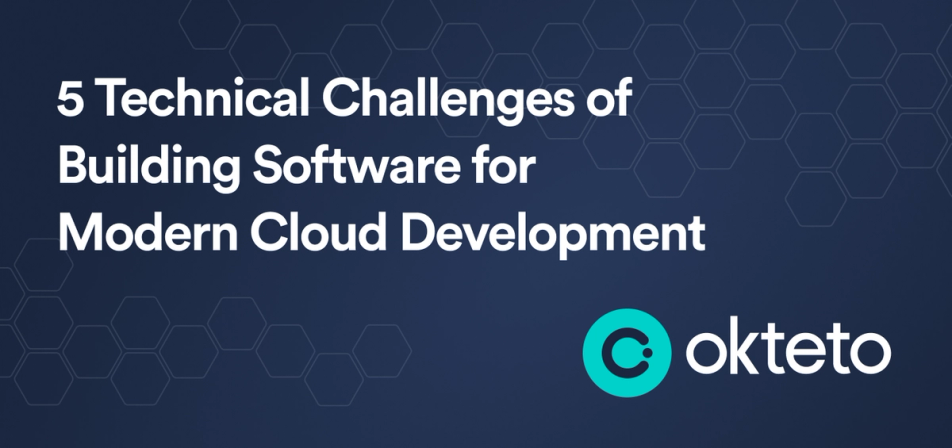5 Technical Challenges of Building Software for Modern Cloud Development

While developing a purpose-built in-house development environment may appear like an obvious way to address specific development challenges, the introduction of Kubernetes, containers, and microservices has made designing and maintaining a modern development environment problematic.
Building an in-house development platform is no longer a technically trivial task.
Some of the most sophisticated engineering companies in the world, including Replicated, LaunchDarkly, monday.com and many more, have come to the conclusion that the technical difficulties of building just weren’t worth it.
"We tried to build it in-house, but that failed," said a Staff Site Reliability Engineer at a high-profile healthcare unicorn. "Companies don't understand the complexity of what's under the hood when building their cloud dev environments, such as the custom resource definitions and technical design needed to work with Kubernetes. Of course, you can create your development portal from scratch, but companies overlook that you need a dedicated team to manage this tool."
Likewise, Replicated, a company that provides delivery and management of Kubernetes applications, discovered building a technically-complicated development platform distracted the team from delivering more essential business value. The platform was also buggy, expensive and costly to maintain.
"Our homegrown solution took a massive investment of our engineering to keep Kubernetes, Docker, and all kinds of cutting edge technologies updated and supported," says Marc Campbell, Replicated co-founder and CTO. "It was difficult, taking our engineering team’s time to support because every day something was broken."
Should You Buy or Build a Development Platform?
5 Technical Challenges of Building Software Internally
If you’re still not convinced that building a cloud development platform is a Herculean task, here are five technical software development challenges that may change your mind:
1. Supporting different development tools and languages
Building a cloud development platform that supports a wide range of development tools and languages can be technically challenging. Each tool and language has its own unique requirements and may require different versions of runtime environments, libraries, and dependencies. This requires careful planning and coordination to ensure that all tools and languages work seamlessly together.
- Pro Tip: Ask if your platform is technically built with pre-configured development images for the following languages: dotnetcore, golang, java, node, php, python, ruby and rust. Additionally, does your development platform work with existing Helm charts, docker-compose, or Kubernetes manifests.
2. Integrating with Kubernetes
Kubernetes is a popular container orchestration platform used for deploying, managing, and scaling containerized applications. Integrating a cloud development platform with Kubernetes can be technically challenging, especially if you're dealing with complex applications and environments. This requires a deep understanding of Kubernetes architecture and best practices, which is a common technical challenge in software development.
- Pro Tip: What’s the cost to technically troubleshoot your in-house solution’s security vulnerabilities and Kubernetes-related updates?
3. Scaling
Scaling as your needs grow requires careful planning and architecture. You need to ensure that your environment can handle increased traffic, data storage, and compute resources without impacting performance. This requires a deep understanding of cloud infrastructure and architecture, as well as expertise in scaling techniques and tools — another technical challenge in software development.
- Pro Tip: Ask if your platform can technically manage multiple moving parts, such as IDEs, Docker, code repos, and endless tooling options?
4. Security
Security means you need to ensure that your platform is secure from unauthorized access, data breaches, and other security threats. This requires expertise in cloud security and best practices, as well as a deep understanding of security threats and mitigation strategies.
- Pro Tip: Ask these questions: Is your solution technically secure enough to support SOCII or ISO27001 security? Can you effectively protect PII? Can your solution cross borders for GDPR compliance?
5. Costs
Building a cloud development environment can be costly, especially if you're starting from scratch. You need to factor in the cost of infrastructure, licensing, and ongoing maintenance and support. This requires careful budgeting and cost analysis, as well as a deep understanding of cloud economics and pricing models.
- Pro Tip: Ask if the technical challenges of building in-house software a constraint to develop, qa, implement and roll-out core features to grow your business?
The Ultimate Build vs Buy Self Evaluation Guide
4 Ways Buying Overcomes the Technical Challenges of Building
Each of these technical challenges requires a different set of skills and expertise to overcome. And while building a cloud development platform can provide you with more control and customization, the technical challenges involved can make buying a better option for many organizations, especially those that want to focus on their core business and get to market faster. The benefits of buying include the following:
- Time to market: Development experiences need significant planning, design, and development time, which can delay the rollout of new applications and features. By purchasing an existing cloud development platform, development teams can save time and quickly begin building and deploying applications.
- Expertise: Building requires a deep understanding of software architecture, engineering, and security. By purchasing a platform, development teams can leverage the expertise of the platform provider, who has already invested significant time and resources in building a robust, secure, and scalable platform.
- Cost: Building requires costly investments in hardware, software, and personnel. By purchasing a platform, development teams can avoid these costs and instead pay a subscription fee to use the platform.
- Maintenance and support: It’s an endless challenge providing ongoing maintenance and support, including updates, bug fixes, and security patches. By purchasing a platform, development teams can leverage the expertise and resources of the platform provider to ensure that the platform remains up-to-date and secure.
At the end of the day ask yourself this: is attempting to overcome the technical challenges of building a cloud development platform your core business? Building requires significant technical expertise, time, and resources. Purchasing a platform can provide the platform engineering team with a more technically modern solution ready for delivering development experiences from dev to deployment.
